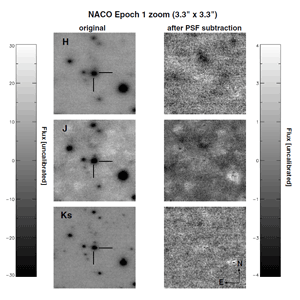- Details
- Published on 27 March 2012
Vol. 540
In section 10. Planets and planetary systems
A frozen super-Earth orbiting a star at the bottom of the main sequence

Microlensing is a powerful technique for detecting low-mass planets at a fraction to a few AU from a parent star floating somewhere between us and the center of the Galaxy. However, it is generally limited by the inability to detect the lens directly, because it is much fainter than the source star and aligned with it. Using VLT/NACO high-resolution imaging in the infrared, both at the time of the event and about two years later, the authors are able to directly detect the lens and characterize the system. Interestingly, the star, only 0.084 Msun, is close to the brown dwarf limit. Its 3.3 Mearth planet orbits at 0.66 AU. This is another example of the ubiquity of planets, particularly small ones, in the Galaxy.


